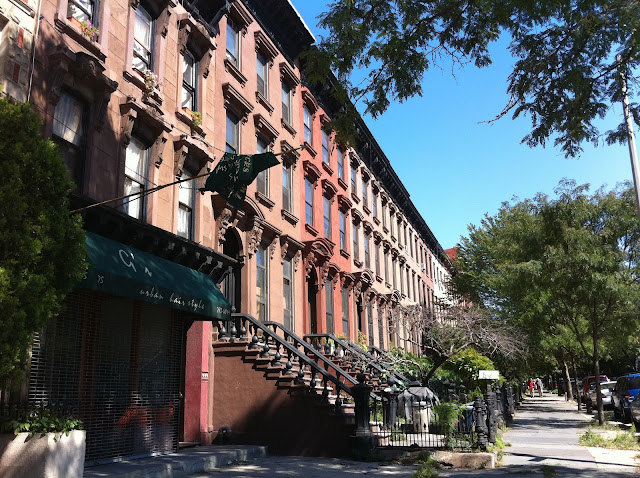As many readers know well,
Brooklyn hosts the largest concentration of nineteenth century buildings made with the building material known as
brownstone. Members of the aspiring upper middle classes of the day, especially from the 1860s through the 1880s, sought out the dark-hued sandstone to lend their houses a distinguished appearance, and the rush to join the fashion of decorating one's home in the versatile material often created a shortage. Rich with red iron oxide, creating deep brownish to red colors, the stone came from nearby quarries in New Jersey, Connecticut, and Pennsylvania and then shipped into Brooklyn by barges.
 |
| Along St. Mark's Avenue, near the intersection with Flatbush Avenue. |
A brownstone mason working on site would affix a thick veneer of the stone to the exterior brick wall of the constructed house. Individual houses were often designed in Greek Revival, Neo Greco, Romanesque, or Italianate styles, or as row houses with one consistent style. Many of these houses featured stoops, wrought iron gratings, and detailed carved decorations, many of which still remain. Obviously, over subsequent decades, other styles of architecture would come into favor.
 |
For example - on the left, Richard Meier On Prospect Park.
1 Grand Army Plaza. Completed 2008. On the right, Brooklyn Public Library. 1941. |
By the 1890s, many architecture critics worried that the material was overused, part of a fad that had carried on much too long.
 |
From The building materials of Pennsylvania:
I.--Brownstones by Thomas Cramer Hopkins of Pennsylvania State College (Busch, State Printer, 1896). |
Novelist
Edith Wharton famously detested the indulgence in brownstone. In her memoir
A Backward Glance, she refers to the New York of her youth as "cursed with its universal chocolate-coloured coating of the most hideous stone ever quarried."
Several neighborhoods in Manhattan sport brownstones, with great ones on the Upper West Side, but Brooklyn has the bounty.
Brooklyn Heights, Park Slope, Bedford-Stuyvesant, Cobble Hill, Fort Greene, and
Prospect Heights feature block after block of residential brownstones, many renovated in the borough's housing boom of the past couple of decades.
 |
| A meandering path on the northwest side of Prospect Park. |
Many well-known writers live among the brownstones today, part of a long literary tradition in Brooklyn. In 1885, the editors of
The Brooklyn magazine, counting the many writers in the city (before its consolidation as a borough of New York City in 1898), observed, "There occurs to our mind no plausible reason why Brooklyn should not become the literary centre of America."
 |
| Garfield Place, Park Slope |
Long before
Paul Auster, Philip Levine, Jhumpa Lahiri, and
Rick Moody, there lived the Brooklyn poet
Will Carleton (1845-1912). A native of rural Michigan, he earned $250 or $300 per poem, an impressive amount for the late nineteenth century, as well as hefty fees from the lecture circuit. He also edited a monthly magazine,
Everywhere, based in Brooklyn. Writers profiling Carleton frequently described a visit with the famous writer in the his three-story Fort Greene brownstone and its cluttered book-lined study on an upper floor.
Yes, the era was characteristically autumnal in color, as urban critic Lewis Mumford observed in
The Brown Decades: A Study of the Arts in America 1865-1895 (originally published in 1931 by Harcourt, Brace and Company, New York; Dover edition, 1971):
"Brownstone began to be used in New York on public buildings in the early fifties, and just on the eve of the war it was first used as a facing for brick houses. With this alteration came dark walnut furniture, instead of rosewood and mahogany, sombre wall papers and interiors whose dark tones swallowed up the light introduced slightly later by the fashionable bay window. By 1880 brown was the predominant note." P. 4
What better way to enter the fall season than to walk in the autumn of New York architecture?
The walk: This walk starts on Lafayette in Fort Greene, proceeds south through Prospect Heights to Prospect Park, takes a westward swing down along Garfield Place in Park Slope, ventures through Gowanus, winds up in Carroll Gardens and then swings up Smith Street in Boerum Hill. The stroll from the park to Smith Street takes a few curves, but it's all pleasantly downhill. Before arriving at Smith Street, you should have seen plenty of brownstones along the way, some applied to commercial buildings.
 |
| Continuing on Garfield Place, Park Slope |
 |
| Garfield Place at 7th Avenue. |
 |
| Carroll Street and Fifth Avenue. Park Slope. |
 |
| View of Gowanus Canal, Gowanus. This part of the walk gets interesting. |
 |
| Intersection of Smith Street and Carroll Street, Carroll Gardens. |
Strolling the brownstone neighborhoods offers the possibility of walking a thousand routes and variations, so the walk described here is merely a starting place or a point of departure. It's unfinished, meaning that an extension to Brooklyn Heights and Cobble Hill was originally planned but will have to take place in the near future. The walk is decidedly frivolous, meaning without depth, as several stops require further consideration.
The gentle slope down Garfield Place makes a nice virtual walk.
View A Walk Among the Brownstones of Brooklyn in a larger map
 |
| An ad for brownstone cutters and stone yards from Important events of the century: containing historical and important events ... By United States Central Publishing Company, New York, 1876. |
Images by Walking Off the Big Apple from Monday, Labor Day, September 6, 2010, in the afternoon. The sky was blue.














Comments
Post a Comment